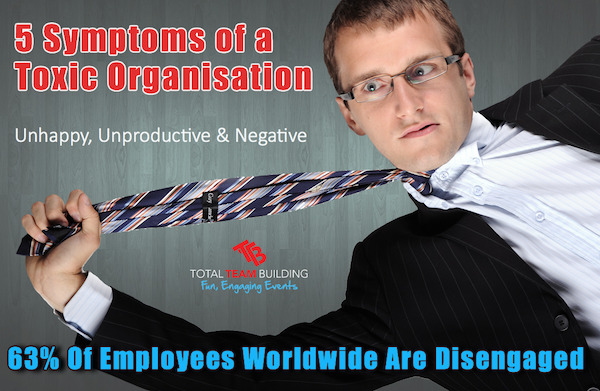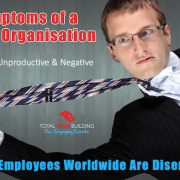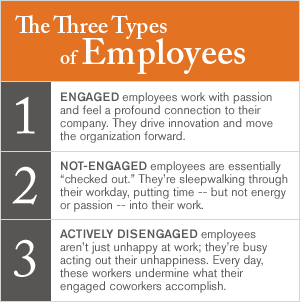5 Symptoms of a Toxic Organisation
In a time where organisations are struggling against a sluggish economy, investing in employees with a focus on team building is even more critical to sustain a profitable and healthy business.
Not every organisation can afford to offer a playground-like environment for its employees (Google) or an on-site culinary team that caters to the ravishing appetites of its workers with free gourmet meals (Facebook). But even the smallest of companies can use team building events to create a healthy workplace environment that fosters innovation, creativity and engagement.

These events are designed to establish a sense of solidarity, confidence and cohesiveness that encourages team members to work toward an equal goal.
Regular team building exercises increase engagement and strengthen relationships among employees, which is critical in developing motivated employees whose goals align with the overall objectives of an organisation.
Without these key elements in place, you’ll have an ailing organisation suffering poor profits.
What are the symptoms of an unhealthy organisation?
1 – Hostile Staff
Psychologically damaging work environments can cultivate outrageous behaviour in employees, allowing them to become unhinged at minor moments of panic.
Consider the United States warehouse worker who shot and killed eight co-workers, and then himself, after losing his job; or the epic meltdown of the flight attendant, who once the plane landed, quit his job over the address system, grabbed two beers, deployed the evacuation slide and made a memorable exit.
Visit NBCNews.com for breaking news, world news, and news about the economy
These are extreme circumstances but there are numerous employees who suffer daily emotional damage due to a poor workplace environment.
2 – Increased Absenteeism
Excessive absenteeism can be due to low morale, burnout or stress, depression, disengagement, poor working conditions or serious illness. This can lead to decreased productivity, which can be financially harmful to an organisation. Companies have to consider the cost of re-staffing, decreased office moral and payable health benefits.
3 – Disengagement
Studies show that employee engagement has an overall impact on the bottom line.
Gallup writes in a 2013 report on workplace disengagement that employee engagement “…Is strongly connected to business outcomes (that are) essential to an organisation’s financial success, including productivity, profitability, and customer engagement.”
Yet disengagement is a worldwide epidemic. Another Gallup study shows that 63% of employees worldwide are disengaged, meaning “they lack motivation and are less likely to invest discretionary effort in organisational goals or outcomes.” Also, 24% are actively disengaged, or unhappy, unproductive and likely to spread negativity among team members.
These unmotivated individuals are crippling the potentially paramount success of organisations.
4 – Difficulty Retaining Top Talent
Employee retention is a primary measure of organisational health. There is a popular saying: “People quit their boss, not their jobs.”
But the competition for top talent is fierce and retaining those superstars is an even greater challenge. High turnover rates, with training, re-staffing and a damaged reputation, can be costly to a business.
Employees need to understand the value of their contributions to the company’s success. Each worker should be treated with dignity and respect in an environment that supports excellence. This includes having pride and confidence in a product or service offered.
5 – Lack of Communication

Effective communication is critical at every level of the organisation. Employees need to be aware of decisions, or included in conversations, that will impact the success of their individual tasks.
Communicating is not exclusive to weekly memos or boardroom meetings – it means being receptive to suggestions and opinions, and asking for feedback.
All of the above can be costly to a brand and experts recommend correcting the issues with training, coaching or team building. Exercises harness the power of play to engage employees and better understand one another while working more effectively as a team to transform a struggling organisation. Contact Total Team Building today and let us help create a fun and engaging culture within your team.
SOURCES:
- Daily Mail UK, Flight attendant: http://www.dailymail.co.uk/news/article-1301798/JetBlue-flight-attendant-Steven-Slater-quits-job-style-luggage-row-passenger.html
- NBCnews.com, Omar Thornton: http://www.nbcnews.com/id/38535909/ns/us_news-crime_and_courts/t/dead-shooting-conn-beer-distributor/
- Gallup Study, Employee Engagement/Productivity: http://www.gallup.com/businessjournal/162953/tackle-employees-stagnating-engagement.aspx
- Gallup, Worldwide Engagement in the workplace: http://www.gallup.com/poll/165269/worldwide-employees-engaged-work.aspx





Leave a Reply
Want to join the discussion?Feel free to contribute!